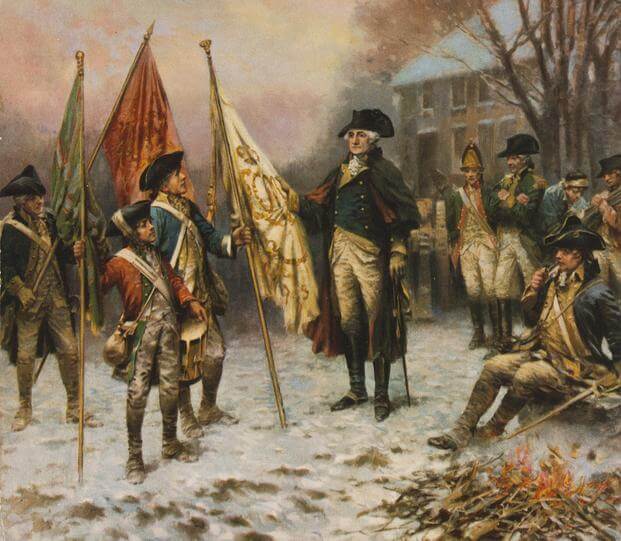The American Revolution was a conflict between Great Britain and its 13 North American colonies, which declared independence as the United States of America. The seeds of the war were the growing colonial dissatisfaction over British taxation and governance. It culminated in a full-scale war for freedom and self-rule for many of the white male colonists.
For the colonists, taking up arms meant defying the world’s most powerful empire -- a bold and dangerous act of courage by ordinary people, many of whom had little formal training or resources.
“The clash pitted a portion of the colonial civilian population against the armed might of one of the greatest maritime powers of the time,” according to a summary by retired Army Lt. Col. John Moncure, a military history scholar.
But the American rebels possessed scrappiness and passion in addition to the home-field advantage. The revolution marked a bold break from monarchy, even though the benefits of independence were unequally distributed, planting both the ideals of democracy and the contradictions with which the new nation would continue to struggle.
Timeline of Battles that Turned the Tide of the War
The Revolutionary War lasted from 1775 until 1783 and ended with the Treaty of Paris, which recognized American independence.
Some of the most significant battles were:
- Battles of Lexington and Concord: A key moment when tensions exploded. The first battles of the American Revolution between the U.S. Minutemen and British on April 19, 1775. In the Battle of Lexington, the Massachusetts militia immediately placed the British in Boston under siege. Eleven months of fighting followed, until the British were driven out of the city.
- Battles of Ticonderoga: Citizen soldiers aided in the capture of this strategic fortress, which impeded the advance of the British along the waterways of Lake Champlain from Canada. Americans captured the fort in 1775, with the British recapturing it in 1777.
- Battle of Bunker Hill (June 17, 1775): The Americans took Bunker Hill and Breed’s Hill as part of the Siege of Boston, but they later lost the hills after several attacks from the British. Although the British won the battle, it came with a loss of many men that greatly weakened their forces.
- Battle of Long Island (Aug. 27, 1776): The British captured New York, driving Gen. George Washington and his army out of New York to New Jersey.
- Battle of Trenton: This battle on Dec. 26, 1776, which defeated German mercenaries, brought morale back to American forces.
- Battle of Saratoga: A turning point of the revolution. American forces defeat British Gen. John Burgoyne and his army in New York state. This battle is also where foreign countries began giving support to America.
- Siege of Charleston: In 1780, after a six-week siege of Charleston, the British captured the South Carolina city.
- Battle of Camden: In 1780, the British captured another South Carolina city.
- The Battle of Kings Mountain (Oct. 7, 1780): American forces achieve a morale-boosting victory by defeating British loyalists in South Carolina.
- The Battle of Cowpens (Jan. 17, 1781): A crucial turning point in 1781 as American forces successfully regained control of South Carolina, leading to the defeat of the British.
- Battle of Yorktown (Sept. 28 to Oct. 19, 1781): Marking the last major battle, Gen. Charles Cornwallis and his army are captured by the American forces under Washington. This pivotal American victory initiates talks with Great Britain.
Read More: The History of the Fourth of July
Major Battles of the American Revolution
Military victories in the American Revolution did more than boost morale, keep public support alive and demonstrate American military growth and determination.
Vitally, they also disrupted British strategy and troop movements, and attracted essential foreign allies (especially France).
Ultimately, Britain was forced to recognize American independence, and international dynamics shifted to lead to the birth of a new nation.
Battle of Bunker Hill (June 1775)
It was the first major conflict of the American Revolution. On the morning of June 17, 1775, colonial patriots awaited the battle in the heights above Boston Harbor. Approaching were the English Redcoats, the most feared fighting force in the world. Low on water and ammunition, the ragged band of farmers-turned-militiamen faced a daunting task.
The English won the battle, but at great cost with 226 Redcoats killed and 828 wounded. The Colonists saw 115 killed and 305 wounded. The casualty count was the highest suffered by the British in any single encounter during the entire war.
Although this was technically a British victory, the heavy British casualties showed that colonial forces could stand up to professional troops, encouraging more support for the revolution.
“The experience at Bunker Hill led the administration in London to realize that ‘a rap on the colonial knuckles’ would not end the conflict,” according to historian Moncure.
As an aside, the Battle of Bunker Hill is a case where the name of a conflict didn't exactly match the geography. It is unknown whether colonial leader Col. William Prescott simply didn’t understand Boston geography or disobeyed orders, but instead of setting up his forces on Bunker Hill, he established the Colonials on Breed’s Hill. On the night before the battle, the colonists were ordered to build a 110-foot wall made of dirt reinforced with hay and fence rails there. The wall proved to be impenetrable by the British until the Americans ran out of ammunition. The conflict retained the name of the original target, Bunker Hill.
Read More: Why Do We Celebrate Independence Day?
Battle of Quebec (December 1775)
The Americans launched a daring but doomed attempt to invade Canada and win French-Canadian support for the Patriot cause. After their success at Fort Ticonderoga earlier that year, commanders such as Gen. Philip Schuyler hoped to keep the momentum going by capturing Quebec, the heart of British power in Canada.
But the campaign fell apart. The troops were sick and lacked adequate supplies. They were also hit by a blizzard as they approached the city, according to the American Battlefield Trust. Quebec’s strong defenses held firm, and the disorganized Patriot forces were forced to retreat. Benedict Arnold tried to lay siege afterward, but British reinforcements ended the effort.
“Benedict Arnold’s expedition to the gates of Quebec City in the fall and winter of 1775 is widely regarded as one of the greatest military marches in history,” according to the Americana Corner. “Arnold, despite his sullied reputation due to his traitorous behavior later in the war, was one of America’s most gifted field commanders, and his tremendous leadership skills were put to the test on this perilous journey.
Ironically, Quebec had already played a key role in shaping the continent. In 1759, the British captured the city from France in a major victory that shifted global power. That earlier battle helped Britain dominate North America, setting the stage for the revolution that followed just years later.
Battle of Trenton (December 1776)

The Patriots’ cause seemed doomed by the end of 1776. George Washington and his troops had suffered greatly, and many men were deserting the newly formed U.S. military. The U.S. Congress even evacuated the city of Philadelphia in anticipation of its fall to the British.
“There was seemingly nothing that could be done to stop or prevent a British victory. Nothing except a campaign so simple yet brilliant in its conception and design that it would forever change the course of world history by its success. It was a campaign that utilized maneuver, surprise, and audacious boldness,” according to an analysis that retired Marine Col. Jeffrey J. Dill, the former commanding officer of 1st Marine Corps District, wrote during his time at Quantico, Virginia.
The Battle of Trenton was a surprise attack in harsh conditions. Washington led 2,400 troops across the icy Delaware River on Christmas night, during a fierce winter storm. The next day, they attacked Hessian mercenaries allied with the British in a surprise maneuver. The battle was won in less than an hour with minimal American casualties.
A few days later, during the Second Battle of Trenton on Jan. 2, 1777 (also known as the Battle of the Assunpink Creek), Washington held off a British counterattack led by Gen. Cornwallis.
The victory reignited hope. It proved that Washington’s army could defeat professional troops, even under desperate conditions. The element of surprise had given the Continental Army a major psychological edge.
Read More: Independence Day Events
Battle of Saratoga (September–October 1777)
What was the turning point of the American Revolution? It was the Battle of Saratoga that turned the tide of the war. Fighting in two battles in the same general area, American forces soundly defeated British Gen. John Burgoyne and his army in New York state.
The battle was brilliantly planned by the apothecary Benedict Arnold of New Haven, Conn., a militia captain devoted to the colonial cause.
Since the battle took place in two stages, the later conflict, on Oct. 7, 1777, is sometimes called the Second Battle of Saratoga or the Battle of Bemis Heights.
Afterward, foreign countries began giving support to America. Most notably, the outcome of this battle convinced France to ally formally with the United States, providing crucial military and financial aid.
The Battle of Saratoga “transform[ed] the war from an isolated revolution of colonies against their mother country, to a ‘world war’ involving several European counties,” according to an Army University Press analysis.
Battle of Cowpens (January 1781)
Another crucial turning point in the Revolutionary War came as American forces successfully regained control of South Carolina, leading to the defeat of the British.
An American commander, Daniel Morgan, had a relatively small army at his disposal, and most of them were amateurs. Yet these Patriots “managed to totally destroy a force belonging to the world's best trained and most feared Army,” according to the scientific documentary “BattleField Detectives.”
The Battle of Cowpens was key because it essentially dashed British plans for the southern colonies. It also forced the British army under Lord Cornwallis into Virginia, where the rebels ultimately laid siege to his forces.
Battle of Kings Mountain (October 1780)
In the Battle of Kings Mountain, American forces achieved a morale-boosting victory by defeating British loyalists in South Carolina. This was different from a lot of other battles because it was mostly Americans fighting other Americans. The Patriots, who wanted to break away from British rule and start their own country, fought the Loyalists, who wanted to stay loyal to the British king and keep things the way they were.
The only person at the battle who wasn’t from America was the British officer in charge of the Loyalists, Maj. Patrick Ferguson. After the Patriots won the battle, many of the Loyalists had to leave; many went to Canada, Bermuda or the Bahamas, according to a National Park Service summary of the battle.
The battles of Cowpens and Kings Mountain were both key victories in the South in part, because American militias used hit-and-run tactics and local knowledge to defeat British forces and Loyalist militias, weakening British control in the region.
Battle of Yorktown (October 1781)

It’s often asked, “What was the most important battle of the Revolutionary War?” or, “Which battle ended the Revolutionary War?” Many historians agree the answer is clear: It was the Battle of Yorktown. Marking the last major battle of the war, it’s sometimes called the Siege of Yorktown. Regardless of the name, it’s widely considered to be the final blow for the British.
British Gen. Charles Cornwallis and his army were captured by the American forces under George Washington’s army, with crucial French military and naval support. Cornwallis surrendered more than 7,000 troops, effectively ending major combat operations.
This pivotal American victory initiated talks with Great Britain so that peace negotiations could begin.
How Military Victories Secured America’s Independence
Military victories were essential in helping America win its independence from Britain. Early successes gave the Patriots hope and encouraged more people to join the fight. As the war went on, key wins showed the American forces were capable of standing up to the powerful British army.
These victories also convinced other countries to support the American cause, providing much-needed supplies, money and troops.
It took some time, but the steady progress on the battlefield wore down British confidence and resources. Eventually, the British government realized continuing the war was too costly and agreed to peace. Without success in battle, the dream of independence might never have become a reality.
Information previously published on Military.com was used in compiling this report.
Want to Know More About the Military?
Be sure to get the latest news about the U.S. military, as well as critical info about how to join and all the benefits of service. Subscribe to Military.com and receive customized updates delivered straight to your inbox.
















